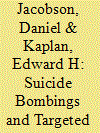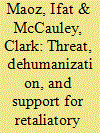| Srl | Item |
| 1 |
ID:
079527


|
|
|
|
|
| Publication |
2007.
|
| Summary/Abstract |
This article develops sequential game models for key operational terrorist (how often to attack) and government (how often to execute targeted killings) decisions taken during a (counter-) terror campaign such as the second intifada. Key results include the following: The government initiates targeted killings when the marginal number of Israeli civilian lives saved from prevented terror attacks exceeds the marginal number of Palestinian civilian lives lost in such ``hits''; targeted killings are not employed if they are either ineffective or extremely effective at thwarting terror (since terrorists will not induce their use); even after accounting for downstream terror attacks motivated by prior targeted killings, a civilian casualty-minimizing government can optimally order targeted killings over time; and low-level cycles of violence can occur when the government is more patient than the terrorists, but higher, stable levels of violence result when the terrorists are the more patient players in the game
|
|
|
|
|
|
|
|
|
|
|
|
|
|
|
|
| 2 |
ID:
080823


|
|
|
|
|
| Publication |
2008.
|
| Summary/Abstract |
Public opinion can permit or encourage retaliatory aggressive state policies against vulnerable but threatening out-groups. The authors present a model in which public support for such policies is determined by perceived threat from and dehumanization of the target group. This two-factor model predicts Israeli Jews' support for two retaliatory aggressive policies: the more hypothetical notion of Palestinian population transfer and concrete, coercive actions toward Palestinians. The authors find (1) that threat and dehumanization are distinct constructs, each having unique contributions to explaining support for aggressive retaliatory policies, (2) that threat and dehumanization significantly explain support for aggressive retaliatory policies when respondents' hawkishness, socioeconomic status (SES), and education level are taken into account, and (3) that the association of hawkishness and SES with support for aggressive retaliatory policies is largely mediated by threat perception. Results are highly consistent across two studies, suggesting the two-factor model may be useful for understanding support for aggressive action in situations of asymmetric conflict
|
|
|
|
|
|
|
|
|
|
|
|
|
|
|
|